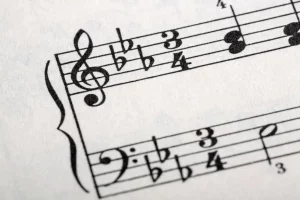Have you ever looked at a piece of piano music and noticed that it is split into two parts? These two parts show the treble clef and bass clef. Together these clefs describe which notes to play in which hands.
Most beginners learn to read the treble clef first. This means that much less time is devoted to reading the bass clef. Even experienced pianists are often much slower at reading bass clef notes.
So if you feel like your left hand notes on piano are lagging behind, then don’t worry. This post is going to teach you some tools that will help you to read bass clef.

What is a bass clef?
The bass clef is a way to notate pitches below middle C. It is also commonly known as F clef because it locates F on the staff. Piano bass clef notes are most frequently played with the left hand.
Why do we need the bass clef?
Bass clef is a useful tool for a few reasons.
- If we only used treble clef, we would have a more limited range of notes to read on one, five line staff. We would need to use an excessive amount of ledger lines and octave higher or lower markings.
- We can easily read pitches below middle C.
- By using both treble clef and bass clef, we can easily discern which parts of the music should be performed with the left hand and which parts should be played with the right hand.
- You can learn to read piano sheet music faster.
Bass clef notes on staff
The bass clef staff consists of five lines and four spaces, each representing specific notes. The bass clef symbol begins with a dot on the fourth line (F line), followed by a curve and two dots framing the F line. This unique design makes recognizing and reading bass clef notes on the staff much easier.

How to draw a bass clef
The bass clef is simple to draw. Begin by drawing a dot on the fourth line of the staff. This line marks F3 on the staff, the F below middle C. Next, draw a curve up to the right and then down and around to the left, like a backwards ‘C’. Once you have this, draw two dots on either side of the fourth line, one in between the fourth and fifth lines and one in between the third and fourth lines.
And there you have it! Your very own bass clef. Keep practicing this, and soon you’ll be able to draw it with your eyes closed! Remember, the bass clef is more than just a symbol; it’s the gateway to the rich, resonating notes that will give your piano music a whole new depth.
Bass clef notes
Reading bass clef notes is easier than you think. The staff consists of lines and spaces, each assigned a note.
Bass clef lines
The five lines of the bass clef staff represent these notes from bottom to top:
G – B – D – F – A

Bass clef spaces
The four spaces represent:
A – C – E – G

How to remember bass clef notes
Still need help memorizing? A bass clef acronym of mnemonics like Good Boys Do Fine Always and All Cows Eat Grass are your best friends! With this basic understanding, you’re well on your way to reading and playing the beautiful, rich tones signified by the bass clef notes on piano. Practice reading bass clef notes on piano often and soon you’ll recognize them instantly.


Bass clef ledger lines below
Sometimes, notes can go below the bass clef staff. These extra notes use ledger lines to indicate lower pitches. Ledger lines are small horizontal lines added above or below the staff to extend its range. Here are some common bass clef notes below the staff:
- E – below the bottom line.
- C – two ledger lines below.
- A – three ledger lines below.
- F – four ledger lines below.
The further below the staff a note is, the lower it sounds. Reading ledger lines requires practice, but recognizing patterns will make it easier over time.

Bass clef ledger lines above
Similarly, notes above the bass clef staff also use ledger lines to extend notation for higher notes. Some frequently used notes above the bass clef staff include:
- C – above the top line – The first ledger line above the staff, also known as Middle C.
- E – two ledger lines above.
- G – three ledger lines above.
- B – four ledger lines above.
For both high and low ledger lines, it helps to recognize intervals between notes instead of reading each note individually. Want to learn more? Check out this handy guide on ledger lines!
Bass clef notes chart
Here’s a bass clef notes chart to help you quickly identify notes on the bass clef:

How to read bass clef on piano
As a budding pianist, understanding how to read the bass clef piano notes is a crucial skill that will enhance your musical journey.
Now that you know the notes, it’s time to apply them to the piano! Follow these top tips:
- Practice daily – Sight-reading improves recognition.
- Use mnemonics to reinforce bass clef lines and spaces.
- Slow down – Accuracy before speed!
- Recognize intervals – Spot note and interval relationships instead of reading one by one.
- Try bass clef exercises – Strengthen your left hand with targeted drills.
Make sure you put this new approach into practice by taking your best piano posture and playing through all the songs in the Piano Beginner 1 course. Intermediates should check out all the great songs from the Intermediate song courses as well.
Bass clef scales
Understanding and practicing bass clef scales is essential for fluent piano playing. Practice bass clef scales with your left hand and be sure to use the correct fingerings for each scale. Here are some common bass clef major scales to practice to put all you’ve learned to the test:
C Major:
- Notes: C – D – E – F – G – A – B – C
- Fingering: 5-4-3-2-1-3-2-1

G Major
- Notes: G – A – B – C – D – E – F# – G
- Fingering: 5-4-3-2-1-3-2-1

F Major
- Notes: F – G – A – Bb – C – D – E – F
- Fingering: 5 – 4 – 3 – 2 – 1 – 3 – 2 – 1

Practicing scales is an essential exercise for any pianist, as it helps build finger strength, coordination, and dexterity. When you learn piano scales in the bass clef range, you not only develop greater control over your fingers but also improve your ability to recognize notes quickly and accurately. This strengthens your muscle memory and enhances your familiarity with lower-pitched notes, making it easier to navigate complex pieces with confidence.
Integrating what you’ve learned
Congratulations! You’ve taken a big step toward mastering the bass clef. By learning bass clef notes on staff, practicing how to read bass clef on piano and using bass clef notes charts. You’re setting yourself up for musical success. Keep practicing, have fun and soon reading bass clef piano notes will feel effortless. Happy practicing!
Explore all types of clefs
Author of this blog post:
Matthew Dickman

With over a decade of experience in music education Matthew holds a BA in Music from Paul McCartney’s LIPA and an MA in Composition from the University of Salford. Mathew has developed a distinctive compositional voice and approach to music theory education through his research and work in the music industry. Matthew’s writing for Skoove combines experience from orchestral and media composition, and as a gigging jazz musician, to create a wholistic and accessible pedagogy for musicians of any level. Away from music, he enjoys reading and exploring nature to expand his horizons and knowledge contributing to his holistic teaching style.














